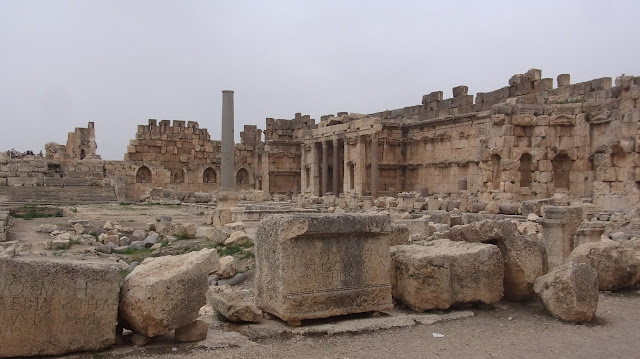 |
| The propylaea (entrance). Replica of the original stairs was added by Kaiser Wilhelm II in the 1890s. |
 |
| Baalbek in the 1880s. Photo from U.S. Library of Congress |
That seems to be a common sentiment. "I can't believe I'm here" was what I heard from the English, Australian Danish and German visitors I met. We were all struck by the dimensions of Baalbek's stones, the height of the columns, the richness of the inscriptions. Bonding quickly, we took turns taking one another's pictures. With a new threat issuing from the other side of the Anti-Lebanon mountain range, there is a fresh urgency to see this place before something unthinkable happens.
 |
| Nearly intact semicircular exedra, with niches for statuary. Plus some dope in the foreground. |
Astonished by its scale, Twain wrote tongue in cheek that "a race of gods or of giants must have inhabited Baalbec many a century ago." Well, giants did walk here. At one point or another, the Canaanites, Alexander the Great, the Roman Emperor Augustus Caesar, Nero, Antonius Pius, Septimus Severus, Caracalla, Philip the Arab, Constantine, Theodosius and Justinian all claimed it as their own.
The temple complex at Baalbek was at its peak under Roman rule; when the Ottomans took over, it receded into obscurity and was allowed to crumble. No accounts of Western visitors precede the 1500s, and it was only in 1751 that a couple of English architects brought it to wider attention outside this remote watershed between the Orontes and Litani rivers. "Remote" being a relative term, of course. The area has been continuously inhabited since at least 7000 B.C.
Sacrifices (animal, I presume) and religious dances, possibly to the goddess Venus, took place in the hexagonal court, below, where 30 granite columns supported an open-air arcade. During the Byzantine era it was likely covered with a dome and converted to a church.
The great court, below, gives an idea of the complex's enormous scale.
Architectural fragments lie about everywhere, many bearing inscriptions or carved embellishments. It's easy to literally trip over a priceless piece of history.
 |
| Archaeologists' trench yields Phoenician foundation, but work seemingly has not resumed after 15-year civil war. |
Above is the south edge of where the Temple of Jupiter stood. Most of its stones and columns have been wrecked or removed over the millennia — some went to build Byzantine churches, including the Haghia Sophia in Istanbul; others were used in Arab fortifications. Of its 54 original columns, these 6 have miraculously survived centuries' worth of earthquakes. They're over 6 stories tall and have their original crowning entablatures. When Israeli airstrikes hit the town of Baalbek in the summer of 2006, the reverberations toppled a column of stones and widened some existing cracks, but life, and the City of the Sun, go on.
Not until a human figure is present can you truly appreciate their size.
The Temple of Bacchus, above, believed to be the site of opium-fueled orgies, is bigger and better preserved than the Parthenon in Athens, embellished by reliefs of Bacchic figures and lions, which the Romans also found worthy of worship.
 |
| Corinthian capitals on Temple of Bacchus |
 |
| Horizontal ... Venus? |
 |
| Sleeping lion: dozing since 150 A.D. |
The temple complex at Baalbek provides many "pinch-me" moments. It's important that a replay of Palmyra not take place here, obviously. Three weeks ago as of this writing, the nihilistic hordes of ISIS were 30 miles away to the northeast in Ras Baalbek. May all the gods, pagan and otherwise, align to protect it.
 |
| Trinket salesman hawks yellow Hezbollah T-shirts for $5USD. No comment. |













This set of pictures is just astounding. I look forward to your postings each day.
ReplyDeleteWow. Incredible. How freely are you able to walk around the ruins? Are areas roped off? Thanks for sharing the pics and historical information!
ReplyDeleteNo restrictions, other than there doesn't appear to be a way of entering the Temple of Bacchus. There are some sheer drops, particularly between Jupiter and Bacchus, that could easily kill or maim a pilgrim, and several sets of steep staircases where a lack of concentration could spell disaster. I'd be worried about bringing a child here.
ReplyDelete